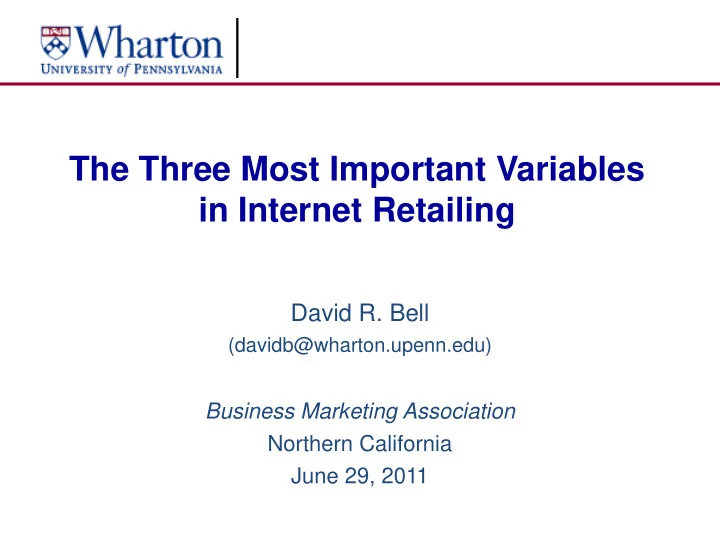

The Three Most Important Variables in Internet Retailing David R. Bell (davidb@wharton.upenn.edu) Business Marketing Association Northern California June 29, 2011
Overview Historical Perspective / Data and Models Four Studies: Findings and Implications “Neighborhood Effects and Trial on the Internet” “Spatio-Temporal Analysis of Imitation Behavior” “Preference Minorities and the Internet” “Traditional and IS-enabled Customer Acquisition”
Historical Perspective “Retail Gravitation Models” Reilly (1930); Huff (1964) Key Ideas Traditional retailers have small trading areas The probability a customer visits a store is inversely proportional to the distance to the store Traditional retailers find it relatively easy to determine customer locations … Key Differences in Internet Retailing
Data and Models Participating Internet Retailers Netgrocer.com, Diapers.com, [Bonobos.com] Typical Data Customer ID, Date, Transaction Value, Zip Code Geo-demographic “real world” data Typical Models Discrete time hazard, Poisson, NBD
Key Ideas Social Contagion from communication and observation affects online demand evolution Spatial Structure follows a pattern of proximity and similarity (spatial “Long Tail”) Preference Isolation brings shoppers online and explains geographic breakdown of online brand demand Acquisition Modes vary in efficacy according to location characteristics
Bell, D. and S. Song (2007) “Neighborhood Effects and Trial on the Internet: Evidence from Online Grocery Retailing,” Quantitative Marketing and Economics.
Neighborhood Effects and Trial Salt Lake City San Francisco New York Las Vegas Los Angeles Phoenix Philadelphia
Neighborhood Effects and Trial Salt Lake City San Francisco New York Las Vegas Los Angeles Phoenix Philadelphia
Neighborhood Effects and Trial Main Findings Customer adoption is “non-random” over space; more likely to • arise in locations contiguous to existing customer locations The neighborhood effect is robust to Internet penetration, • observed geo-demographic heterogeneity and unobserved heterogeneity The marginal effects are economically meaningful for the firm • • Location still matters in Internet retail, but it is the location of customers relative to other customers and to offline options
J. Choi, K. Hui, and Bell, D. (2010) “Spatio- Temporal Analysis of Imitation Behavior Across New Buyers at an Online Grocery Retailer,” Journal of Marketing Research .
Spatio-Temporal Imitation Geographic and “Demographic” Neighbors LA Chicago Springfield
Spatio-Temporal Imitation The number of new buyers in zip i at time t is Poisson distributed with λ it λ ~ Poisson( ) y it it ′ λ = + γ + τ + ζ + β W + β G + β D + ε log( ) log( ) n x z G z D z it it i i t t it t ( ) i t t ( ) i t it Offset Regional Temporal Error Imitation effect effect effect n : the number of people yet to try (Netgrocer.com) it γ γ σ 2 (0, ) N : unobserved regional heterogeneity, γ i i x : observed regional heterogeneity i ζ : temporal baseline effect t ε ε σ 2 (0, ) N : error, ε it it 12
Spatio-Temporal Imitation Main Findings Customer base grows through proximity initially, then later via • “similarity” among physically distant locations Proximity effects “tap out” but similarity effects hold at a • steady rate of accumulation Market seeding strategies that combine the two effects lead to • increased total sales • Internet retailers benefit from serving sparse pockets of geographically diverse demand (spatial “Long Tail”)
J. Choi and D. Bell (2011) “Preference Minorities and the Internet,” Journal of Marketing Research (forthcoming).
Preference Minorities The Long Tail Sales Distribution Sales Market 1 Popular brands Niche brands 100 Others Generation Seventh Pampers 100 Babies Huggies Luvs Sales Rank G 7 versus Available in Market 2 Available in Market 1 Market 2 Available Online Market 1 Market 2 1900 Others Assortment at local retailers 100 Babies Demand for online retailers 15
Preference Minorities Findings and Implications Target segment size alone is insufficient; “preference minority • status” of target group is key Customer s in the preference minority have higher offline • shopping costs; less price-sensitive and more receptive to shopping online “Preference minority markets” have disproportionately higher • online category sales; effect strongest for niche brands • Preference isolation drives consumers online, explains geographic variation in demand, and decomposition of niche vs. popular brand sales
J. Choi, D. Bell, and L. Lodish (2011) “Traditional and IS-enabled Customer Acquisition on the Internet,” Management Science , (forthcoming).
Customer Acquisition
Customer Acquisition Traditional Acquisition Methods IS-enabled Acquisition Methods (a) Offline Word-of-Mouth (b) Online Word-of-Mouth Customer- generated Acquisitions per Zip Code ( Interdependence at the individual consumer level) (c) Magazine Advertising (d) Online Search Firm-initiated Acquisitions per Zip Code ( Independence at the individual consumer level)
Customer Acquisition Using zip codes with 1+ buyers Using zip codes with 10+ buyers
Geo-Targeting A Comparison of Expected New Buyers Per Household and Click-to-Order Conversions 1 Number of Actual Expected Expected Buyers per HHs Conversion Cities 2 Buyers Buyers w/ Children Rates Top Two Groups 1 6857 6646 .102 .183 7 2163 1934 .050 .182 Middle Two Groups 35 2045 2083 .009 .102 42 1595 1573 .009 .099 Bottom Two Groups 42 1436 1480 .004 .078 30 1105 1084 .005 .076 Notes 1 In the interests of space, we show only six clusters of cities. Full information for all 50 clusters is available from the authors upon request. 2 This best performing group includes one city, New York City. The number of cities in the other groups is variable, but all cities in a group have roughly equal predictions for the expected number of new buyers per household.
Customer Acquisition Findings and Implications Acquisitions in general and word-of-mouth (WOM) acquisitions • in particular benefit from physical proximity among targets ( offline WOM—contagion; online WOM—connectivity) Location-based benefits have stronger effects when senders • and recipients of WOM are co-located Different acquisition modes are complementary and • substantial gains from geo-targeting are possible • Acquisition mode by geography interaction creates substantial opportunities for Internet retailers
Discussion
Recommend
More recommend